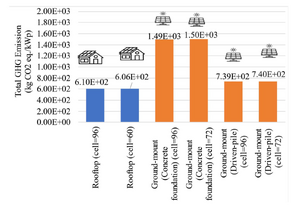
Purpose
Both the capital cost and levelized cost of electricity of utility-scale ground-mounted solar photovoltaic (PV) systems are less than those of representative residential-scale solar rooftop systems. There is no life cycle analysis (LCA) study comparing the environmental impact of rooftop PV system and large utility-scale solar PV system. This study aims to fill this knowledge gap and provide a comprehensive LCA of a representative 7.4 kWp rooftop and 3.5 MWp utility-scale solar PV systems from cradle to grave.
Methods
The energy as well as CO2 and water footprint during the manufacture, use, and end of life of both systems will be quantified. The primary focus of this study will be on the LCA of racking/mounting systems as these are the greatest source of divergence between the two main system types. In addition, sensitivities are run on (1) PV module types, (2) footings for the ground-mounted systems, and (3) geographic locations in different states of the USA.
Results
Overall, the embodied energy per kWp of the rooftop-mounted PV system is 21–54% lower than that of the utility-scale ground-mounted PV system. The higher embodied energy of the ground-mounted systems is so much larger than the rooftop systems that even sub-optimally oriented rooftops still have substantially lower energy payback times in all regions. Similarly, the greenhouse gas emissions attributed to the ground-mount system with rack a is 2.5 times, and ground-mount system with rack b is 1.2 times greater per kWp than that of the rooftop system. A rooftop solar PV system requires 21 to 54% less input energy, emits 18 to 59% less CO2eq. of greenhouse gas emissions, and consumes a reduced quantity of water ranging from 1 to 12% per kWp. The energy payback time of rooftop solar systems is approximately 51 to 57% lower than that of ground-mounted solar systems across all locations.
Conclusions
Overall the CO2 payback time was 378 to 428% higher for ground-mounted PV compared to rooftop PV for the same modules and 125 to 142% higher for ground-mounted compared to rooftop PV for the most common modules used for both applications. Although water use is dominated by the PV modules themselves, it is important to note that the water consumption for the utility-scale ground rack is approximately 260 times (rack a) and 6 times (rack b) higher than that of the rooftop mounting structure.
Data: https://osf.io/g6bjp/
In the Media[edit | edit source]
- Small-scale solar has key benefits, and one critical weakness, over large solar farms The Conversation
- Roof top solar proves to have key benefits over large solar farms Energy Daily
- Small-scale solar best for environment but agrivoltaics may be the answer PV Magazine USA
- PV Magazine International
- Optimizing Environmental Benefits: Agrivoltaics Surpass Small-Scale Solar Solutions Ace Battery
- Solar distribuída é boa para o meio ambiente, mas agrovoltaica pode ser melhor PV Magazine Brazil
- Αμερικανοί επιστήμονες συνέκριναν τα φωτοβολταϊκά με τα αγροβολταϊκά - Μελέτη έκπληξη Energy Mag (Greece)
See also[edit | edit source]
- Life cycle assessment of pasture-based agrivoltaic systems: Emissions and energy use of integrated rabbit production
- The Greenest Solar Power? Life Cycle Assessment of Foam-Based Flexible Floatovoltaics
- Greener Sheep: Life Cycle Analysis of Integrated Sheep Agrivoltatic Systems
- Life cycle analysis of silane recycling in amorphous silicon-based solar photovoltaic manufacturing




